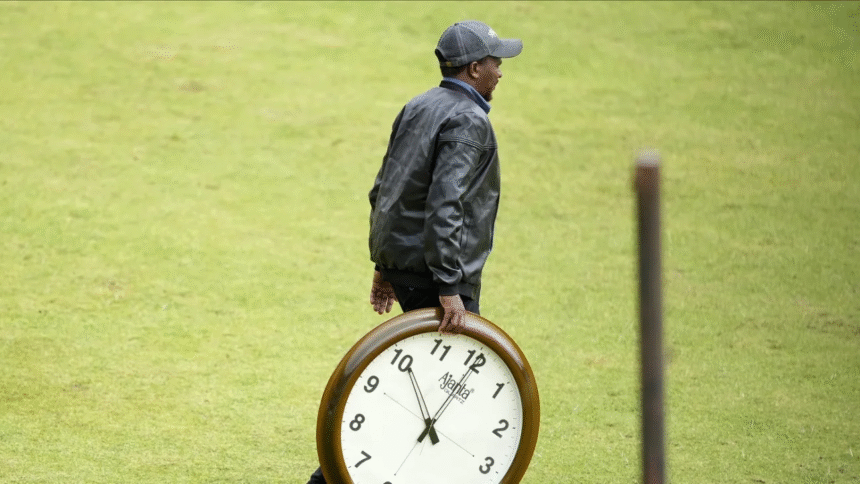Cricket fans, get ready—because the game is evolving, and the ICC Stop-Clock Rule is leading the charge. The International Cricket Council (ICC) has introduced a wave of new rule changes across formats, aiming to improve the pace, fairness, and spectator experience of international cricket. From timing over rates in Tests to revamped DRS protocols, these tweaks are set to change how the game is played and watched.
Let’s break it all down in a simple, conversational way so you’re fully updated before the next big match.
ICC Stop-Clock Rule: It’s About Time
Ever felt a Test match dragging on forever? Enter the ICC Stop-Clock Rule—designed to speed up over rates and keep things moving. Already trialed in limited-overs formats, it now makes its way to the traditional five-day game, starting from the 2025–27 World Test Championship cycle.
How the ICC Stop-Clock Rule Works:
- The fielding side must begin the next over within 60 seconds of the previous one ending.
- Two official warnings will be issued for delays.
- On the third delay, the batting team is awarded five penalty runs.
- The clock resets every 80 overs, giving teams some breathing room.
This ICC Stop-Clock Rule is already live in ODIs and T20Is for Full Member nations since June 1, 2024. Now it’s Test cricket’s turn. It’s a big move—and long overdue.
Saliva Ban Gets a Tweak (But Still No Licking the Ball)
The saliva ban isn’t going anywhere, but there’s a small update. Previously, if saliva was found on the ball, umpires were quick to swap it out. Now, they’re taking a more case-by-case approach.
The New Take:
If the ball’s condition hasn’t changed drastically, umpires might let the game continue. This prevents fielding teams from intentionally applying saliva just to force a ball change. Cheeky move? Not anymore.
DRS: Some Key Changes You Need to Know
The Decision Review System (DRS) is getting a couple of significant updates, especially around how reviews are process and rule. Let’s unpack it.
Secondary Review Default: ‘Out’
Imagine a batter reviews a caught-behind decision. UltraEdge shows no edge, but the ball hits the pad. The TV umpire then checks for LBW, and guess what? The default assumption now is ‘out’ unless proven otherwise.
-
So even if ball-tracking says “umpire’s call”, the batter is still out. Harsh? Maybe. But it’s all about consistency.
Chronological Reviews for Combined Appeals
When both teams and umpires review different things from the same delivery—like an LBW and a run-out—the TV umpire will now check them in the order they happened.
First comes the LBW, then the run-out. Clean, fair, and less confusing.
No-Ball? Catch Still Counts!
Here’s a funky rule update.
Let’s say a batter hits the ball, it’s caught, but then—oh wait!—the umpire realizes it was a no-ball. Under the old rules, that catch didn’t matter.
Now? The catch will still be review for fairness.
- If it was clean: the batting side only gets one run for the no-ball.
- If it wasn’t clean: they get however many runs they complet.
It’s about making every play count, even if the bowler goofed.
Deliberate Short Runs: Now With a Twist
The five-run penalty for deliberately running short (trying to steal an extra run) is still there.
But now, the fielding side gets to choose which batter stays on strike afterward. It’s a small change, but it could be a big strategic edge late in a game.
Player Replacement Trial: Injury Substitutes Coming?
The ICC wants member Boards to try out a new rule in domestic First-Class games: injury-based player replacements.
If a player suffers a “serious external injury”, teams can bring in a like-for-like substitute.
Think of it as the concussion sub rule, but broader. A logical step in the name of safety, right?
Concussion Protocols: More Strict Than Ever
Speaking of concussions, there are two new protocols:
Mandatory Concussion Replacements
Each team must name a designated concussion replacement before the match starts. This stops teams from picking a sub mid-game who might offer an unfair advantage.
Seven-Day Stand-Down Rule
If a player gets a concussion, they’re out for at least seven days—no exceptions. This is based on advice from the ICC Medical Advisory Committee, and it’s all about protecting players’ long-term health.
Powerplay Rules Adjusted for Shortened T20s
T20 matches sometimes get cut short due to rain or other interruptions, but the powerplay rules didn’t always adapt well. That’s fix now.
Here’s the updated powerplay allocation based on innings length:
| Overs | Powerplay Overs |
|---|---|
| 6 | 1.5 |
| 7 | 2.1 |
| 8 | 2.2 |
| 9 | 2.4 |
| 10 | 3.0 |
| 11 | 3.2 |
| 12 | 3.4 |
| 13 | 3.5 |
| 14 | 4.1 |
| 15 | 4.3 |
| 16 | 4.5 |
Now you know exactly how many overs will be under the fielding restrictions.
Wide Ball Rule Reworked for Fairness
The ICC is making it a bit easier for bowlers in white-ball cricket (ODIs and T20Is) when batters start moving around like dancers at a wedding.
What’s Change?
-
Umpires will now judge wides based on where the batter’s legs are at the time of delivery—not where they end up after shifting.
-
A ball that passes between the leg stump and a new ‘protected area marker’ won’t be a wide—even if it looked ugly on replay.
Bonus:
The protected area marker will now extend to the popping crease, giving umpires a clearer visual guide.
Why the ICC Is Doing This
If you’re thinking, “That’s a lot of changes,” you’re absolutely right. But it all boils down to three key goals:
-
Speed up the game – especially with the ICC Stop-Clock Rule.
-
Protect players’ health – through updated concussion protocols and injury subs.
-
Enhance fairness and transparency – from DRS to wides to deliberate short runs.
Read More: The Unstoppable Rise of Mohammed Siraj: India’s Fiery Spearhead in Bumrah’s Absence
Conclusion
From the long-anticipated ICC Stop-Clock Rule in Tests to smarter reviews and expanded safety measures, these aren’t just minor updates—they’re a modern overhaul of the sport we love.
Whether you’re a hardcore Test purist or a T20 thrill-seeker, these updates are bound to shake things up. So next time you’re watching a match and wondering why a batter is out on “umpire’s call,” or why the next over started bang on the minute—now you’ll know why.
As the 2025 season rolls around, keep your eyes on the little things. In cricket, as in life, it’s often the tiny tweaks that make the biggest impact.







